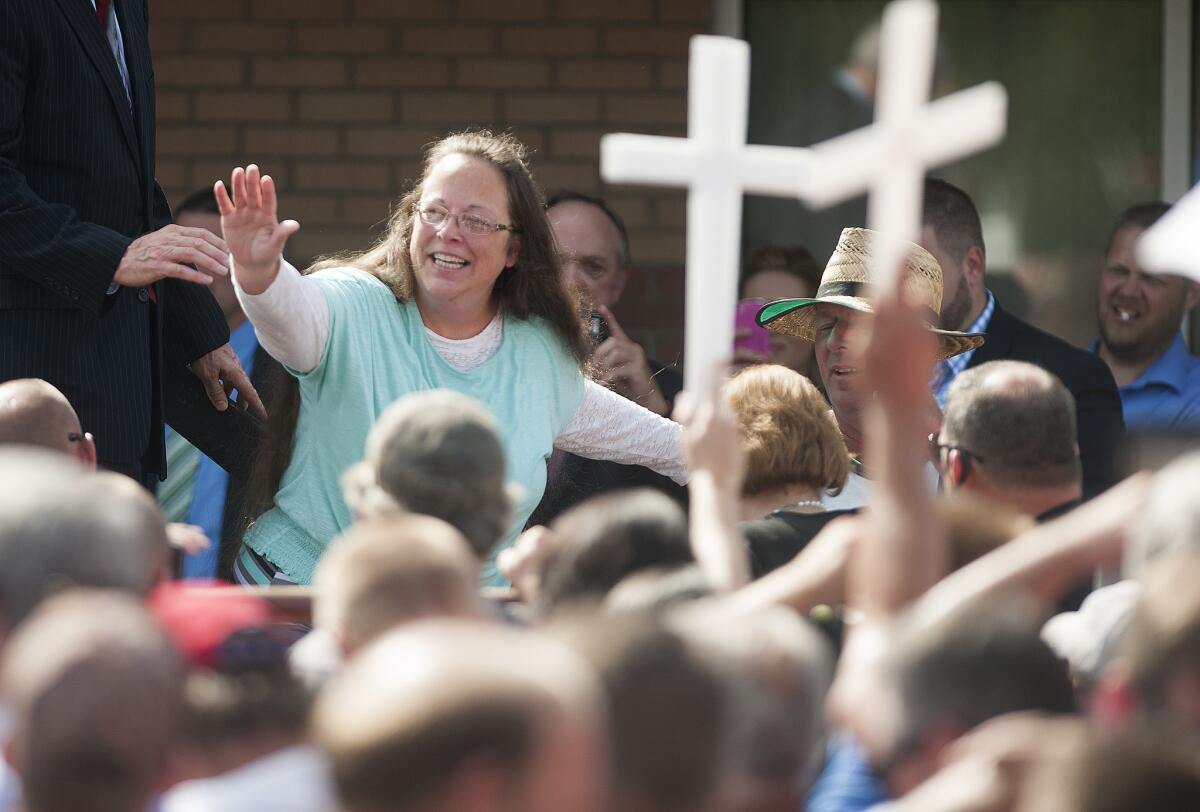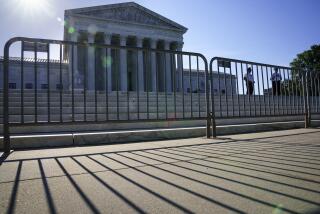The Supreme Court is already pulling us back to the future

- Share via
The Supreme Court opened the 2020 term Monday, the first Monday in October, and the incipient hard-right majority quickly flexed its muscles. Two immediate moves send clear signals that the court is poised to take an ax to landmark constitutional holdings that define important aspects of American society now.
Most dramatically, the longest-serving two members of the new majority — Justices Clarence Thomas and Samuel Alito — published a concurrence with the court’s decision not to accept a case that was eyebrow-raising on its own terms, and even more alarming as a portent of a sharp doctrinal swing.
In Davis vs. Ermold, the justices declined to hear a case brought by a county clerk in Kentucky who refused to issue wedding licenses to same-sex couples because it would interfere with her religiously based opposition to such marriages. Same-sex unions have been the law of the land since the Supreme Court’s landmark 2015 decision in Obergefell vs. Hodges, which held that a prohibition on gay marriage violates the Constitution’s guarantee of equal protection.
On Monday, Thomas, joined by Alito, made it clear that they would like to overrule Obergefell, which they see as a “threat to the religious liberty of Americans” whose faith tells them that marriage is “a sacred institution between one man and one woman.”
It rang a loud alarm on a potent crosscutting issue — religious liberty — made more disconcerting because the court had previously indicated that it was not in the business of distinguishing among sincerely held religious beliefs, no matter how unusual or intolerant (as in the case of the Kentucky county clerk).
Think about the implications. It’s no doubt true that the right to marry no matter your sexual preferences chafes certain sincere religious adherents, but why should it be their objections to the practices of others that take constitutional priority? Should the same religious-liberty rebalancing occur if someone objects as a matter of faith to the bar against prayer in school? What about employment discrimination on the basis of sexual orientation, which just last term the court found to be prohibited by Title VII?
Adding to the ominousness of the opinion is the fact that Thomas and Alito published it in the first place. They agreed that for technical legal reasons the court should not take up Davis vs. Ermold, and then they seized an opportunity to lay down a marker for the enemies of same-sex marriage: Come on in, the water is fine.
And it’s about to get finer with the potential addition of Amy Coney Barrett to the court. Barrett has already signaled her disagreement with the Obergefell decision and her relatively lax view of the force of stare decisis. As she sees it, precedent modestly encumbers the overruling of even foundational decisions that have stood the test of earlier challenges, and on which hundreds of thousands of Americans have built their lives.
And there was more Monday. Thomas and Alito, this time joined by Justice Neil Gorsuch, indicated in a case out of South Carolina that we could expect these three to take a crabbed approach to voting rights. In an unsigned order, the court reversed a District Court and a Court of Appeals that had both agreed to suspend a state requirement that absentee ballots include a witness’ signature. With a pandemic raging, the two lower courts determined the rule to be overly onerous and a violation of the right to vote.
The Supreme Court reinstated the state law but made an exception for already-cast ballots received within two days of the order. Thomas, Alito and Gorsuch, however, disagreed about that exception: They would have simply invalidated any unwitnessed ballots. In this fraught electoral season, a faction of the court has shown how little it cares about protecting the franchise.
Looking forward, Thomas and Alito’s endorsement of “religious liberty” will cast a strong shadow over one important case already on the court’s docket. In Fulton vs. Philadelphia, a Catholic social services group says Philadelphia’s nondiscrimination requirements, which could force adoption agencies to place children with same-sex couples, violates the church’s teaching that marriage is limited to a man and a woman. Look for the court to rule against Philadelphia, particularly if Barrett is seated.
Keep an eye as well on the “shadow docket” — cases such as Davis vs. Ermold — in which the court rules without issuing a full-blown written decision by, for example, imposing or setting aside a stay. If the court puts its thumb on the scale of the upcoming election, that kind of ruling is how it probably will happen.
The 2020-21 shadow docket also provides a first look at the new majority’s stance on abortion. The Trump administration is seeking an emergency order to reinstate the FDA’s rule that abortion pills must be dispensed in a medical office or clinic, not through the mail or with a prescription called in to a pharmacy. A federal judge in Maryland had blocked the rule because the pandemic was curtailing doctor visits, which in turn affects a woman’s ability to exercise her reproductive rights.
These cases have a common theme: They provide the court with the opportunity to roll back rulings that match the practices and views of a majority of Americans but that many conservatives believe have changed society for the worse. The new Supreme Court, minus Ruth Bader Ginsburg, has sent us a message: Buckle up for a fast ride back to the future.
More to Read
A cure for the common opinion
Get thought-provoking perspectives with our weekly newsletter.
You may occasionally receive promotional content from the Los Angeles Times.






